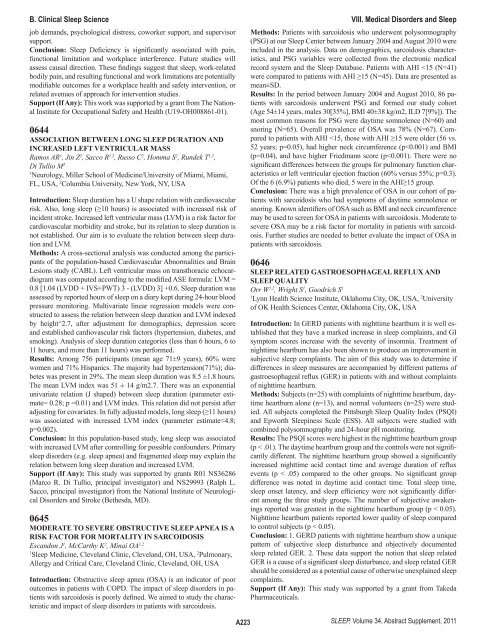SLEEP 2011 Abstract Supplement
SLEEP 2011 Abstract Supplement
SLEEP 2011 Abstract Supplement
You also want an ePaper? Increase the reach of your titles
YUMPU automatically turns print PDFs into web optimized ePapers that Google loves.
B. Clinical Sleep Science VIII. Medical Disorders and Sleep<br />
job demands, psychological distress, coworker support, and supervisor<br />
support.<br />
Conclusion: Sleep Deficiency is significantly associated with pain,<br />
functional limitation and workplace interference. Future studies will<br />
assess causal direction. These findings suggest that sleep, work-related<br />
bodily pain, and resulting functional and work limitations are potentially<br />
modifiable outcomes for a workplace health and safety intervention, or<br />
related avenues of approach for intervention studies.<br />
Support (If Any): This work was supported by a grant from The National<br />
Institute for Occupational Safety and Health (U19-OH008861-01).<br />
0644<br />
ASSOCIATION BETWEEN LONG <strong>SLEEP</strong> DURATION AND<br />
INCREASED LEFT VENTRICULAR MASS<br />
Ramos AR 1 , Jin Z 2 , Sacco R 1,2 , Russo C 2 , Homma S 2 , Rundek T 1,2 ,<br />
Di Tullio M 2<br />
1<br />
Neurology, Miller School of Medicine/University of Miami, Miami,<br />
FL, USA, 2 Columbia University, New York, NY, USA<br />
Introduction: Sleep duration has a U shape relation with cardiovascular<br />
risk. Also, long sleep (≥10 hours) is associated with increased risk of<br />
incident stroke. Increased left ventricular mass (LVM) is a risk factor for<br />
cardiovascular morbidity and stroke, but its relation to sleep duration is<br />
not established. Our aim is to evaluate the relation between sleep duration<br />
and LVM.<br />
Methods: A cross-sectional analysis was conducted among the participants<br />
of the population-based Cardiovascular Abnormalities and Brain<br />
Lesions study (CABL). Left ventricular mass on transthoracic echocardiogram<br />
was computed according to the modified ASE formula: LVM =<br />
0.8 [1.04 (LVDD + IVS+PWT) 3 - (LVDD) 3] +0.6. Sleep duration was<br />
assessed by reported hours of sleep on a diary kept during 24-hour blood<br />
pressure monitoring. Multivariate linear regression models were constructed<br />
to assess the relation between sleep duration and LVM indexed<br />
by height^2.7, after adjustment for demographics, depression score<br />
and established cardiovascular risk factors (hypertension, diabetes, and<br />
smoking). Analysis of sleep duration categories (less than 6 hours, 6 to<br />
11 hours, and more than 11 hours) was performed.<br />
Results: Among 756 participants (mean age 71±9 years), 60% were<br />
women and 71% Hispanics. The majority had hypertension(71%); diabetes<br />
was present in 29%. The mean sleep duration was 8.5 ±1.8 hours.<br />
The mean LVM index was 51 ± 14 g/m2.7. There was an exponential<br />
univariate relation (J shaped) between sleep duration (parameter estimate=<br />
0.28; p =0.01) and LVM index. This relation did not persist after<br />
adjusting for covariates. In fully adjusted models, long sleep (≥11 hours)<br />
was associated with increased LVM index (parameter estimate=4.8;<br />
p=0.002).<br />
Conclusion: In this population-based study, long sleep was associated<br />
with increased LVM after controlling for possible confounders. Primary<br />
sleep disorders (e.g. sleep apnea) and fragmented sleep may explain the<br />
relation between long sleep duration and increased LVM.<br />
Support (If Any): This study was supported by grants R01 NS36286<br />
(Marco R. Di Tullio, principal investigator) and NS29993 (Ralph L.<br />
Sacco, principal investigator) from the National Institute of Neurological<br />
Disorders and Stroke (Bethesda, MD).<br />
0645<br />
MODERATE TO SEVERE OBSTRUCTIVE <strong>SLEEP</strong> APNEA IS A<br />
RISK FACTOR FOR MORTALITY IN SARCOIDOSIS<br />
Escandon J 1 , McCarthy K 2 , Minai OA 1,2<br />
1<br />
Sleep Medicine, Cleveland Clinic, Cleveland, OH, USA, 2 Pulmonary,<br />
Allergy and Critical Care, Cleveland Clinic, Cleveland, OH, USA<br />
Introduction: Obstructive sleep apnea (OSA) is an indicator of poor<br />
outcomes in patients with COPD. The impact of sleep disorders in patients<br />
with sarcoidosis is poorly defined. We aimed to study the characteristic<br />
and impact of sleep disorders in patients with sarcoidosis.<br />
Methods: Patients with sarcoidosis who underwent polysomnography<br />
(PSG) at our Sleep Center between January 2004 and August 2010 were<br />
included in the analysis. Data on demographics, sarcoidosis characteristics,<br />
and PSG variables were collected from the electronic medical<br />
record system and the Sleep Database. Patients with AHI

















